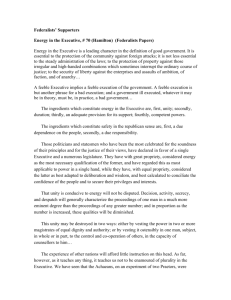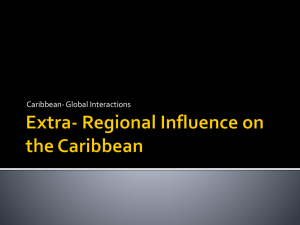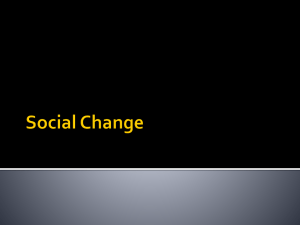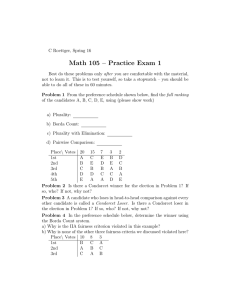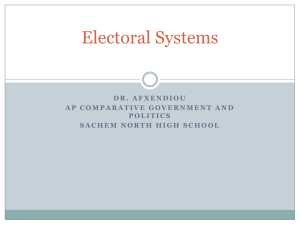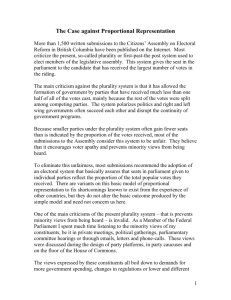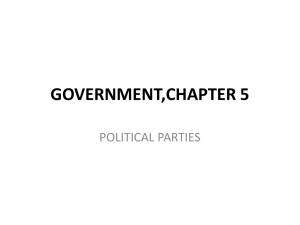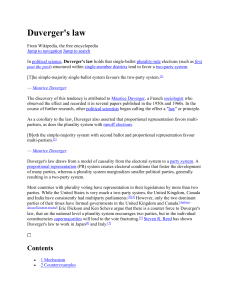File - McTigue AP Gov & Politics
advertisement
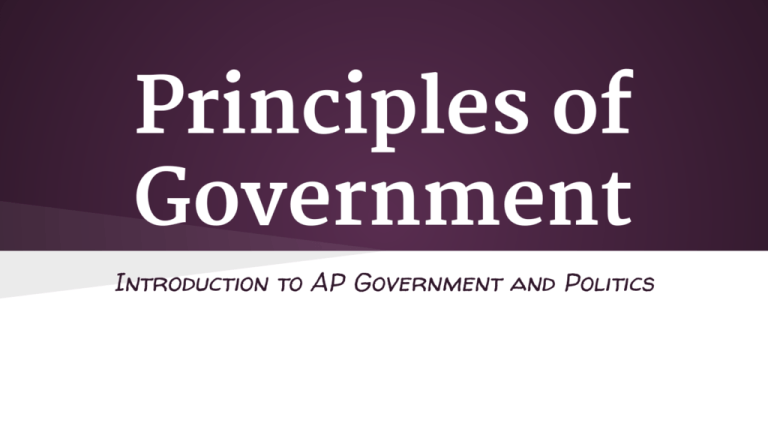
Principles of Government Introduction to AP Government and Politics Learning Objectives 1.) Identify the meaning of government. 2.) Explore the purpose of government. 3.) Explain the various distribution of power. 4.) Describe the various forms of government. What is government? The institutions, people, and processes by which a nation-state or political unit is ruled and its public policy created. ● Nation-State: a form of political organization under which a relatively homogeneous people inhabits a sovereign state; especially : a state containing one as opposed to several nationalities Nation vs. State NATION ● Psychological rather than an institutional concept. ● Cultural, linguistic, and other identities that tie people together. ○ ex: Chechens - Russia STATE ● Broader concept that includes all institutions and individuals that exercise power. What is politics? Activities that relate to influencing the actions and policies of a government or getting and keeping power in a government. What is the purpose of government? 1.) 2.) 3.) 4.) 5.) Protection/Sovereignty Maintenance of public order Resolution of social conflicts Responsibility for a stable economy Provision of public service How is power distributed? ● Evolution Theory ○ ex: tribal rule ● Force Theory ○ ex: Hitler & Germany ● Divine Right Theory ○ ex: monarchy (UK) ● Social Contract Theory: ○ power to govern was a result of decisions made freely by the people. How is Power gained/maintained? ● Marxist Theory (Marx) ○ those who hold control of the economy have the real power in a society ○ Government in merely a tool of the rich ■ ie: corporation and financial institutions ● “Power Elite” (Mills) ○ important policies are made by three groups: ■ corporate leaders, top military offices, and a few key political leaders How is Power gained/maintained?* ● The Bureaucrats (Weber) ○ elites are not well-known, visible heads of state or business tycoons, but people behind the scenes. ○ bureaucrats whose expertise and specialized talents are responsible for managing societies. ○ carry out the day to day workings of government and hold the real power. ● The Pluralists ○ elites are not easily identified as one specific group holding power, money or prestige. ○ Power is split among many different elites Forms of Government Elites may spread political power in three different ways: 1. Geographic distribution 2. Separation of powers 3. Number of participants Geographic distribution Governments may center their power in one location, or scatter power among several places. ● Unitary Government - all powers of the government are held by a single unit or agency ○ ex: Great Britain or China ● Federal Government - governmental powers are divided between a central authority and a number of regional political subdivisions. ○ ex: United States or Mexico Geographic distribution ● Confederation - political system in which a weak central government has limited authority and states have ultimate power. ○ ex: European Union Systems of Government For a fun break from the notes -Check out this Monty Python video clip! :) The Annoying Peasant Legislative & Executive Branches ● Power may be distributed between those that make the laws and those that execute the laws. ● Power may not to divided equally. Legislative & Executive Branches Parliamentary Government ● form of government in which the executive leaders are chosen by and responsible to the legislature. ● Prime Minister - chosen from the majority party in power. Presidential Government ● form of government in which the legislative and executive branches are separate and function independently. ● Chief executive holds a fixed term and is chosen separately from the legislature by popular vote **Hybrid Government ● Combination of parliamentary and presidential system. ○ Prime Minister works closely with the legislature and the President has an independent power base. ■ Ex: Russia Number who participate Aristotle’s early attempt to classify governments according to its members who participate: ● Rule by one ● Rule by few ● Rule by many Rule by one ● Absolute Monarchy ○ Ruler gains power through inheritance ○ Absolute = no restraints on power ○ Monarchs are ceremonial or constitutional. ■ Generally have little power ● Dictatorship ○ absolute ruler controls the power, often through fear or force, ignores the will of the people. ○ Modern version of autocracy ○ Does not allow political opposition. Rule by few ● Aristocracy ○ Rule by the finest ■ Social position, wealth or education ● Theocracy ○ power lies in the hands of a religious group ○ rarely exists in pure form ○ ex: Iran ● Political Party ○ Ex: China - controlled by Communist party ○ Leaders are selected from tops ranks for party Rule by many ● Direct or Participatory Democracy ○ democratic system of government in which all citizens participate in politics and decision-making. ● Democratic Centralism ○ government is democratic if it serves the true interest of the people. ■ Associate with communist party ■ Decisions made through community discussion ● Representative Democracy ○ democratic system of government in which policies are made by officals accountable to the people who elected them. Linkage Institutions Groups that connect the government to its citizens: ● Political Parties ● Interest Groups ● Print and electronic media Electoral Systems and Elections rules that decide how votes are cast, counted, and translated into seats in a legislature. ● First-past-the-post - denoting an electoral system in which a candidate or party is selected by achievement of a simple majority. ○ Single Member District Plurality - (SMDP) cand compete for a single representative’s seat. ○ AKA: Plurality system or winner-take-all Plurality System ● Individual candidates run in single-member districts ○ Votes case for individual candidates ■ Candidate with more votes than other candidates wins the seat ● One result is a two (or few) party system Proportional Representation ● Voting is arranged in multimember districts. ○ Voters cast voters for parties ■ Seats are divided among parties on the basis of percentages of overall vote. ● Proportional representation generally results in a multiparty system. Mixed System ● Voting is arranged in combination of multimember and single-member districts. ○ Voters cast votes for individuals and parties ■ Some seats are filled by winners in plurality races; others are filled by party ● A mixed system results in an inbetween number of parties.
